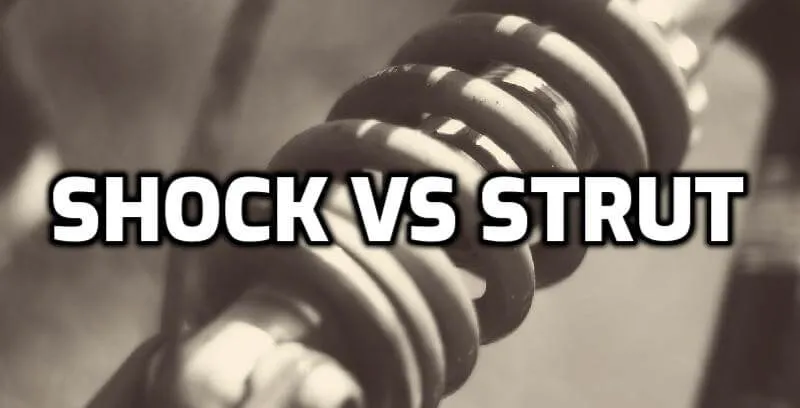Shock vs Strut: What’s the Difference?

Shock absorbers and struts are both suspension components for cars. They work to keep the car level when driving over bumps in the road, which makes them a necessary part of any vehicle. Shock absorbers dampen the impact that occurs from going over bumps by converting kinetic energy into heat, while struts provide support for other parts of your car’s suspension system.
What is more important? It depends on what you’re looking for! In this article we’ll compare these two important components so you can make an informed decision about which one suits your needs best.
Shock Absorbers
Shock absorbers are found at the top of each coil spring and work to keep your suspension working smoothly. By converting kinetic energy into heat, shock absorbers give a smoother ride by lessening the impact that occurs when you go over bumps in the road or drive up an incline. The different types of shocks available for cars also come with differing levels of damping – which means they offer varying degrees of control depending on what it is you need from them! As well as having various settings, there are many brands to choose from so finding one will depend largely on personal preference too. We will cover this more below in our section about choosing between brands if you’re not sure yet. Shock absorbers can be installed in either the front or rear of a vehicle.
Struts
The strut works to support other components within your car’s suspension system, and there are two types: semi-independent and fully independent struts which will give you different levels of control over how smoothly your ride is (as well as some variation depending on what type it is). A key factor with struts is that they’re not adjustable so if you need one for an older model then you’ll have to get a kit which includes all the necessary parts. If you buy a new set however, then these kits won’t be needed because the struts should come preassembled from the manufacturer. The main reasons why most people decide to change their shocks before their struts is because the struts are more expensive, and they have an increased lifespan of about 50% more than shocks.
Key Difference Of Shock Vs Strut
- Shock absorbers are designed to soften the blow of bumps and jolts, while struts do not.
- Strut suspensions are usually heavier than shock absorber suspensions, as they have to absorb more energy in order to work properly.
- Struts take up a lot of space, so if you’re looking for a vehicle with as much interior room as possible then struts are not the best option.
- Struts can be fitted with air or hydraulic fluids to help with the shock absorbing process, while shocks are not designed to be fluid-based.
- Struts can only absorb so much energy before they need to be replaced.
- Shock absorbers, on the other hand, are designed to last a lifetime.
- Struts like coil springs are prone to squeaking.
The main difference between shock absorbers and struts is the function. Shock absorbers dampen motion of a vehicle to help reduce vibration, improve handling, and help smooth out bumps.
Both work to stabilize and support a vehicle’s suspension, but they are different in their construction and function. Shock absorbers help reduce vibration while struts provide structural stability for a vehicle’s suspension system.
Shock absorbers are found on the underside of a vehicle’s chassis or frame that will absorb vibrations from the road. Shock absorber springs allow motion when they’re not compressing but stop it when they do compress.
This provides some give to keep a driver in control while riding over soft obstacles like snow, sand or gravel. Struts are a system of parts that work together to support the weight and height of an automobile suspension from either side. Their main function is to provide structural stability by supporting the vehicle’s sprung mass as well as its unsprung weight. A strut will also control wheel articulation over bumps, keeping tires in contact with the ground.
Both work to stabilize and support a vehicle’s suspension, but they are different in their construction and function. Shock absorbers help reduce vibration while struts provide structural stability for a vehicle’s suspension system.
Conclusion
If you’re looking for a car with improved handling or more comfort in your ride, then shock absorbers may be the answer. If however you just need to make sure that your car has some kind of suspension system and is not too noisy when going over bumps, struts are what will work best. This article covers all about the difference, construction, and function of shocks vs struts.
Frequently Asked Questions (FAQ)
How do I know if I need shocks or struts?
There are a few things you can keep an eye out for that may indicate it’s time to replace your shocks or struts. If your car feels bouncy when driving over bumps, if you notice fluid leaks around the shock absorbers, or if your vehicle is sagging in the rear, it’s probably time for new shocks or struts. Another good indicator is if you find yourself having to constantly adjust your steering to keep the car going straight – this means the shocks or struts are no longer able to properly dampen the movement of the suspension, making it more difficult to control the car. Of course, the best way to know for sure is to have a professional inspection. A qualified mechanic will be able to tell you whether your shocks or struts need to be replaced, and can help you choose the right replacement parts.
Related Article
